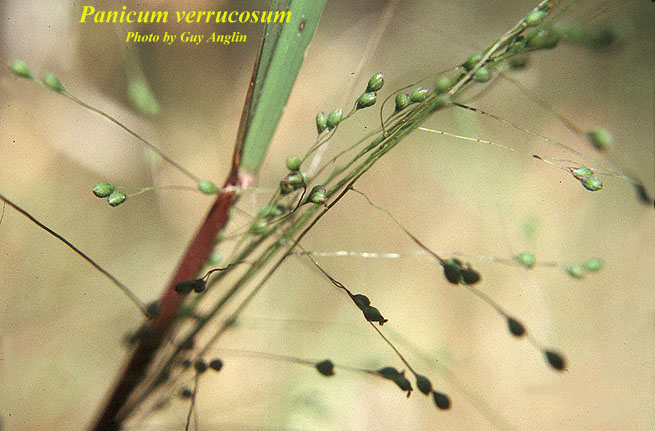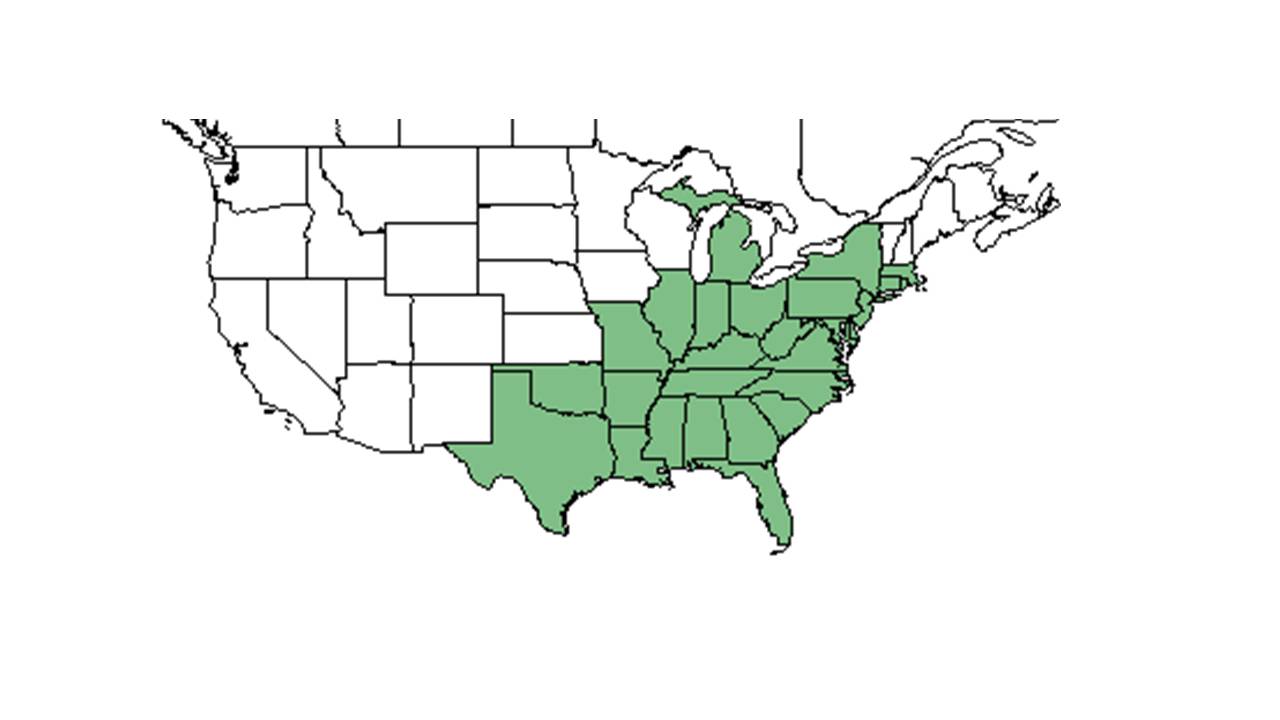Panicum verrucosum
| Panicum verrucosum | |
|---|---|

| |
| Photo by Guy Anglin, Atlas of Florida Vascular Plants | |
| Scientific classification | |
| Kingdom: | Plantae |
| Division: | Magnoliophyta - Flowering plants |
| Class: | Liliopsida – Monocotyledons |
| Order: | Poales |
| Family: | Poaceae ⁄ Gramineae |
| Genus: | Panicum |
| Species: | P. verrucosum |
| Binomial name | |
| Panicum verrucosum Muhl. | |

| |
| Natural range of Panicum verrucosum from USDA NRCS Plants Database. | |
Common name: Warty panicgrass
Contents
Taxonomic notes
Description
Panicum verrucosum is an annual graminoid species. [1]
Distribution
Ecology
Habitat
P. verrucosum occurs in moist to wet, sandy or loamy soils, including sandy loam, loamy sand, and sandy peat. [2] It can be found in pine-wiregrass savannas, wooded floodplains, pond pine-titi peat swamps, sandhills, cabbage palm-mixed hardwood hammocks, and bordering bodies of water, including Cypress-gum ponds, lakes, Hypericum bogs, and ephemeral depression marshes. [2] Furthermore, this species appears in some disturbed areas, including near trails and borrow pits, and in ditches, clear-cuts, and power line corridors. [2] P. verrucosum responds positively or not at all to soil disturbance by clearcutting and roller chopping in North Florida.[3] It also responds positively to soil disturbance by clearcutting and chopping in North Florida flatwoods forests.[4]
Associated species include Pinus palustris, Andropogon ternarius, Muhlenbergia expansa, Aristida stricta, Cyrilla, Ilex, Myrica, Cypress, Liquidambar styraciflua, Hypericum, Xyris, Rhynchospora, Schizachrium, Eupatorium, Scleria, Plea, and Zigadenus. [2]
Phenology
Flowering and fruiting have been observed in June, September, October, and December. [2]
Seed dispersal
This species is thought to be dispersed by gravity. [5]
Seed bank and germination
The species showed a significant increase in abundance after tilling (soil disturbance), and was abundant in seed banks. [1] Germination depends on exposed soil and possibly disturbance caused by drought. [6]
Fire ecology
P. verrucosum is found in cut-burned areas of a Chamaecyparis thyoides stand in the Great Dismal Swamp. [7]
Conservation and management
Cultivation and restoration
Photo Gallery
References and notes
- ↑ 1.0 1.1 Kirkman, L. K. and R. R. Sharitz (1994). "Vegetation disturbance and maintenance of diversity in intermittently flooded Carolina bays in South Carolina." Ecological Applications 4: 177-188.
- ↑ 2.0 2.1 2.2 2.3 2.4 Florida State University Robert K. Godfrey Herbarium database. URL: http://herbarium.bio.fsu.edu. Last accessed: June 2014. Collectors: Loran C. Anderson, John B. Nelson, Sidney McDaniel, L. J. Brass, Paul O. Schallert, R. Kral, R.K. Godfrey, James P. Gillespie, Angus Gholson, A. H. Curtiss, D. B. Ward, J. Hunter, F. S. Ward, Cecil Slaughter, R. A. Norris, and R. Komarek. States and Counties: Florida: Alachua, Baker, Calhoun, Duval, Franklin, Gadsden, Gulf, Highlands, Jefferson, Lafayette, Leon, Liberty, Nassau, Okaloosa, Osceola, Putnam, Seminole, Taylor, Wakulla, and Walton. Georgia: Atkinson, Grady, and Thomas.
- ↑ Lewis, C.E., G.W. Tanner, and W.S. Terry. (1988). Plant responses to pine management and deferred-rotation grazing in north Florida. Journal of Range Management 41(6):460-465.
- ↑ Moore, W.H., B.F. Swindel, and W.S. Terry. (1982). Vegetative Response to Clearcutting and Chopping in a North Florida Flatwoods Forest. Journal of Range Management 35(2):214-218.
- ↑ Kirkman, L. Katherine. Unpublished database of seed dispersal mode of plants found in Coastal Plain longleaf pine-grasslands of the Jones Ecological Research Center, Georgia.
- ↑ Kirkman, L. K. and R. R. Sharitz (1994). "Vegetation disturbance and maintenance of diversity in intermittently flooded Carolina bays in South Carolina." Ecological Applications 4: 177-188.
- ↑ McKinley, C. E. and F. P. Day (1979). "Herbaceous production in cut-burned, uncut-burned and control areas of chamaecyparis thyoides (L.) BSP (Cupressaceae) stand in the Great Dismal Swamp." Bulletin of the Torrey Botanical Club 106: 20-28.